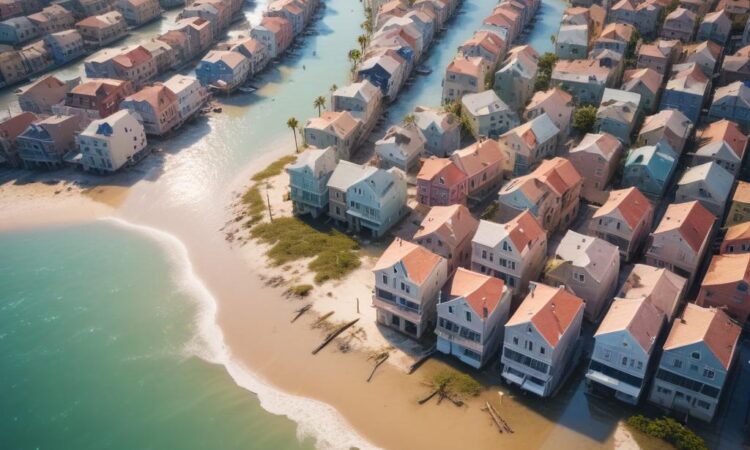Climate Change Threatens Coastal Cities with Rising Sea Levels
A recent study warns that coastal cities around the world are at risk of significant flooding due to rising sea levels caused by climate change, highlighting the urgent need for mitigation and adaptation strategies.
The Threat of Rising Sea Levels
Climate change is causing the Earth’s average temperature to rise, leading to the melting of glaciers and ice sheets. This meltwater flows into the oceans, causing sea levels to rise. The Intergovernmental Panel on Climate Change (IPCC) has projected that sea levels could rise by as much as 1 meter by 2100, with some regions experiencing even higher rises. This increase in sea levels poses a significant threat to coastal cities, as it can lead to:
- Increased flooding: Higher sea levels will result in more frequent and severe flooding, especially during storms and high tides. This can inundate homes, businesses, and infrastructure, causing extensive damage and displacement.
- Erosion: Rising sea levels can accelerate coastal erosion, leading to the loss of beaches, cliffs, and other valuable land. This erosion can threaten coastal ecosystems and infrastructure.
- Saltwater intrusion: Higher sea levels can push saltwater further inland, contaminating freshwater sources and impacting agriculture and drinking water supplies.
- Displacement of populations: Rising sea levels and associated flooding can displace entire communities, forcing them to relocate to higher ground.
Vulnerable Coastal Cities
Many major coastal cities around the world are highly vulnerable to the impacts of rising sea levels. Some of the most at-risk cities include:
- New York City, USA: Home to millions of people and a major financial hub, New York City is vulnerable to flooding from both rising sea levels and storm surges.
- London, UK: London’s low-lying areas are at risk of flooding, particularly during periods of high rainfall and high tides.
- Mumbai, India: Mumbai is one of the most densely populated cities in the world, and its coastal areas are vulnerable to flooding and erosion.
- Shanghai, China: Shanghai is a major economic center and faces significant threats from rising sea levels and typhoons.
- Tokyo, Japan: Tokyo is home to millions of people and a key economic hub. Its coastal areas are vulnerable to flooding and earthquakes.
Mitigation and Adaptation Strategies
Addressing the threat of rising sea levels requires a two-pronged approach:
Mitigation
Mitigation measures aim to reduce the rate of climate change and limit the overall rise in sea levels. These include:
- Reducing greenhouse gas emissions: The primary driver of climate change is the emission of greenhouse gases, such as carbon dioxide. Transitioning to renewable energy sources, improving energy efficiency, and adopting sustainable practices are crucial for reducing these emissions.
- Protecting and restoring natural ecosystems: Forests, mangroves, and wetlands play a vital role in mitigating climate change by absorbing carbon dioxide and protecting coastlines from erosion. Conservation and restoration efforts are essential for maintaining these ecosystems.
Adaptation
Adaptation measures focus on adjusting to the impacts of rising sea levels that are already occurring or are inevitable. These include:
- Seawalls and levees: Building seawalls and levees can help protect coastal areas from flooding. However, these structures can be expensive to build and maintain, and they can also disrupt natural coastal processes.
- Raising buildings and infrastructure: Raising homes, businesses, and critical infrastructure above projected sea levels can reduce the risk of flooding.
- Land-use planning: Planning for future sea-level rise by restricting development in vulnerable areas and promoting sustainable development practices can help minimize risks.
- Early warning systems: Implementing early warning systems for storms and coastal flooding can provide valuable time for people to evacuate and minimize potential damage.
- Building resilient infrastructure: Designing infrastructure to be more resistant to flooding and storm surges can reduce damage and improve safety.
The Urgency of Action
The threat of rising sea levels is a pressing issue that demands immediate action. Delaying action will only increase the risks and costs associated with climate change. Implementing effective mitigation and adaptation strategies is crucial to protect coastal cities, communities, and ecosystems from the devastating impacts of rising sea levels.
Conclusion
Climate change is a serious threat to coastal cities around the world, and rising sea levels are a major concern. Urgent action is needed to mitigate the effects of climate change and adapt to the rising sea levels. By implementing mitigation measures, such as reducing greenhouse gas emissions and protecting natural ecosystems, and adaptation strategies, such as building seawalls, raising infrastructure, and implementing land-use planning, we can minimize the risks and protect our coastal communities from the devastating impacts of climate change.

